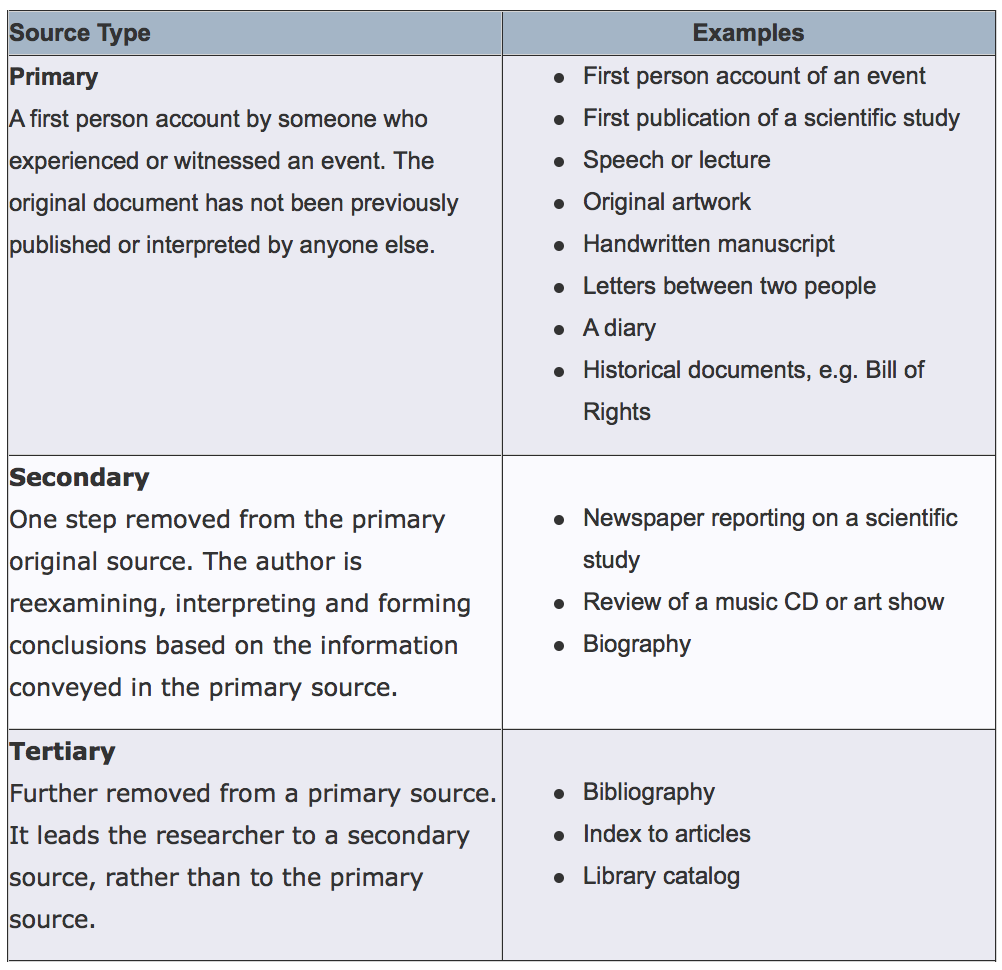

When evaluating the quality of the information you are using, it is useful to identify if you are using a primary, secondary, or tertiary source. By doing so, you recognize if the author is reporting on his/her own first-hand experiences or relying on the views of others.
Primary sources provide firsthand testimony or direct evidence concerning a topic or question under investigation. They are usually created by witnesses or recorders who experienced the events or conditions being documented. Often these sources are created at the time when the events or conditions are occurring.
"Primary sources . . . are defined as the direct evidence of a time and place that you are studying – any material (documents, objects, etc.) that was produced by eyewitnesses to or participants in an event or historical moment under investigation. Secondary sources, in contrast, are interpretations – often generated by scholars – that are based upon the examination of multiple primary sources." (from Primary Source.org)
What types of primary sources might have been produced that would be relevant to your topic?
Which persons or organizations might have produced materials?
Possible formats include:

On the 6th floor of Central Library, Special Collections specializes in (PRINT) historical materials relating to
Texas Archival Resources Online (TARO)
(TARO) contains Special Collections' detailed guides. (SEARCH FOR: University of Texas at Arlington Library, Special Collections in drop down menu)
For scholars and students researching this important period in American history, culture, and politics.
The Sixties: Primary Documents and Personal Narratives 1960-1974 contains diaries, letters, autobiographies and other memoirs, written and oral histories, manifestos, government documents, memorabilia, and scholarly commentary. Spanning 1960 to 1974, The Sixties is centered on key themes that provide insight into the issues that shaped America and that still resonate in today's debates: Arts, Music, and Leisure; Civil Rights; Counter-Culture; Environmental Movement; Gay and Lesbian Rights; Law and Government; Mass Media; New Left and Emerging Neo-Conservative Movement; Science and Technology; Student Activism; Vietnam War; and Women's Movement.
A collection of books, pamphlets and periodicals reflecting the evolution of a feminist consciousness and the movement for women's rights.
The Gerritsen curators gathered more than 4,500 publications from continental Europe, the U.S., the United Kingdom, Canada, and New Zealand, dating from 1543-1945. The Gerritsen Collection consists of two segments: the Periodical Series and the Monograph Language Series.
The New York Times (1851-2007)
Offers full-page and article images with search-able full-text back to the first issue.
Dallas Morning News Historical Archive(1885-1984)
Important resource for Texas History.
Chicago Defender (1956-1973)
The Chicago Defender has been a leading voice of the black community, with more than two-thirds of its readership outside Chicago. A full-image is provided for the newspaper.
A full-image archive that includes the entire historical run of the newspaper from 1889 - 2013. See also The Wall Street Journal archive (1984 - Current).
ProQuest Historical Newspapers: The Wall Street Journal (1889 - 2002): In 1889, Dow Jones & Company first published The Wall Street Journal (formerly known as the Customers' Afternoon Letter) as a markets-focused newspaper for the country's then-fewer than 200,000 shareholders. Today, it focuses not only on the stock market, but on all aspects of global business, economics, consumer affairs, and trends and issues. Online researchers have access to more than 100 years of The Journal's accurate reporting, exclusive analysis, agenda setting, editorials, and controversial opinions. In addition to the printed stories, researchers also can study the charts, stock tables, graphics, and illustrations featured in the publication. With this resource, users can study the development of industries and companies across decades, monitor the implementation and effects of fiscal policies on the global economy, study opposing viewpoints at critical times in the world's history, and more. This title is especially appealing to those interested in business, finance, economics, and journalism.
Here are some of the maps from Special Collections

Except where otherwise noted, this work is licensed under a Creative Commons Attribution-NonCommercial 4.0 International License. For details and exceptions, see the Library Copyright Statement.
© 2016-23 The University of Texas at Arlington.
University of Texas Arlington Libraries
702 Planetarium Place · Arlington, TX 76019 · 817-272-3000